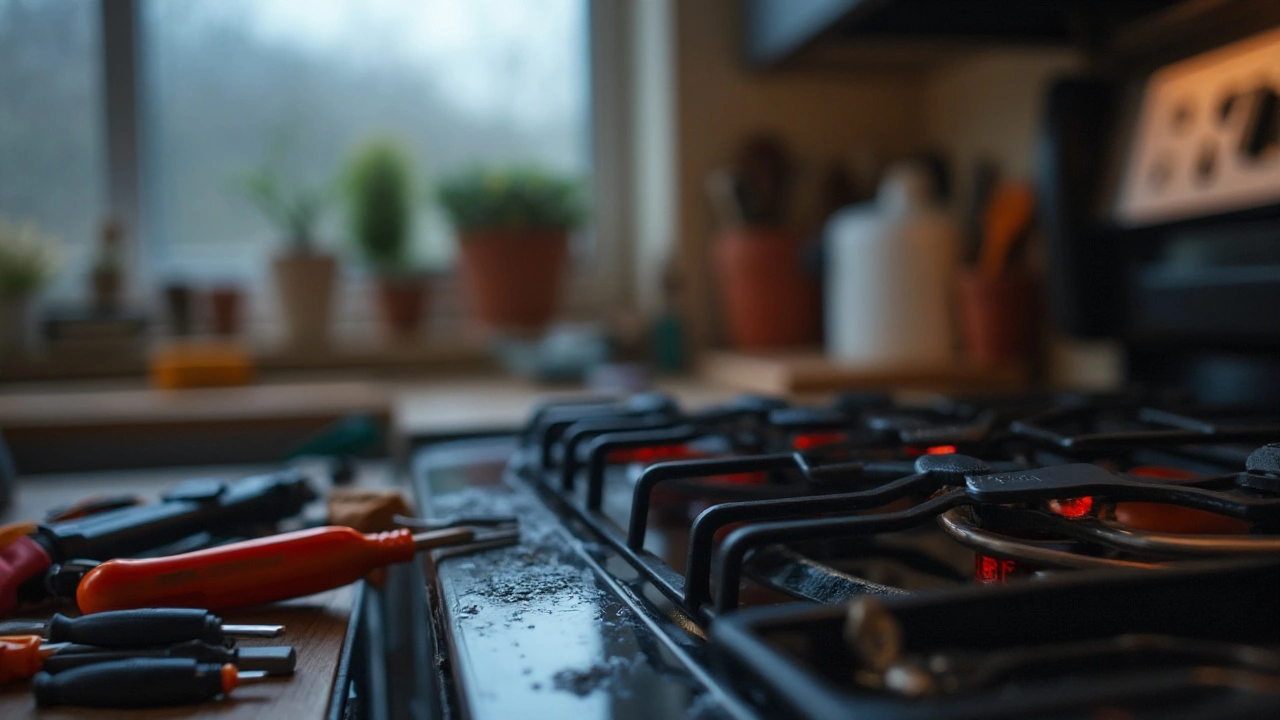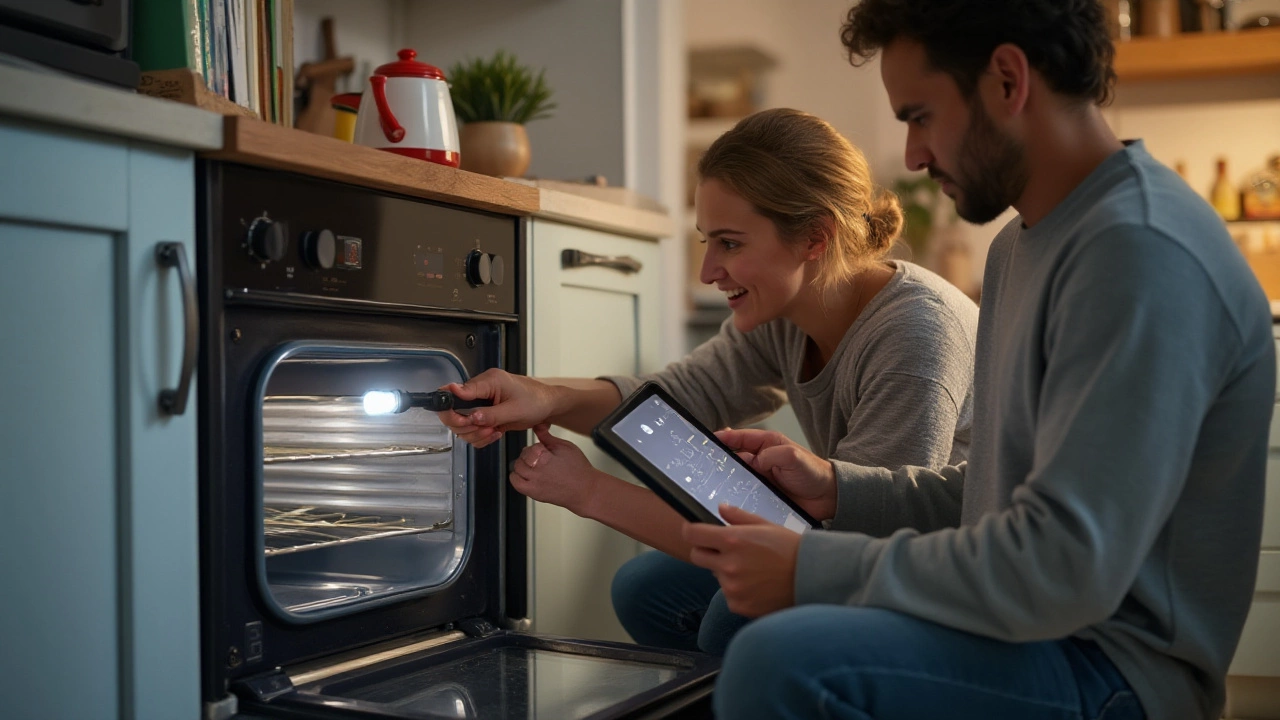Finding that your electric oven has unexpectedly stopped working can be quite a hassle. Whether you're an occasional baker or an everyday cook, a broken oven disrupts the rhythm of any kitchen. But before dialing the repair service, there's a world of simple checks and fixes you might consider exploring right at home.
An array of issues could cause your oven to fall silent – from a tripped circuit breaker to a faulty heating element. The good news is, armed with a bit of knowledge, many problems are solvable without professional help. Rolling up your sleeves can both save time and cut down on repair costs.
This guide sheds light on common causes and offers troubleshooting steps rooted in simplicity and effectiveness. It will walk you through practical solutions while emphasizing the importance of safety in all DIY endeavors. With the right approach, you'll have your oven heating up again in no time.
- Common Reasons for Oven Malfunction
- Basic Troubleshooting Techniques
- Safety Tips During Repairs
- Proactive Maintenance for Longevity
Common Reasons for Oven Malfunction
When an electric oven decides to snooze during cooking time, it throws a wrench into meal plans. Often, the trouble is down to more basic issues than one might initially suspect. For starters, a blown fuse or tripped circuit breaker is a surprisingly common problem that halts your appliance in its tracks. It's no different from what happens when you plug too many devices into a single power strip, and they all demand more juice than the circuit can provide. If your oven shares a circuit with other high-demand appliances, like a microwave or fridge, there's a high chance they've joined forces to trip the breaker. A quick visit to your home’s circuit panel may identify this issue and solve it in minutes.
Next up, you might bump into problems with the oven's heating elements, the most hardworking parts of your machine. The bake and broil elements, responsible for the top-down and bottom-up heat respectively, might fail due to metal fatigue or other natural wear and tear. Visual checks can reveal if an element is at fault. Blackening or blistering is a telltale sign it’s burned out. While these elements are generally reliable, time and repeated use are their foes. When one goes kaput, replacing it often restores the oven to its former glory.
Another possible source of frustration is with the oven's temperature settings. If your meals are constantly undercooked or scorched before the time’s up, the thermostat might be misbehaving. A faulty thermostat means the oven either doesn’t know how hot it is or can't adjust accordingly. It's akin to driving a car without a functioning speedometer – you could be going too fast or too slow with no precise knowledge of the pace. Adjusting or replacing the thermostat might require a bit more technical savvy or assistance from an appliance service expert.
"The number one issue we see is users accidentally disconnecting their ovens from power," says appliance repair expert Michelle Thompson. "Often, the solution is simply making sure the power connection is intact."
Electronic control board malfunctions also rank among common oven issues. This board acts like the brain of your appliance, directing all operations once you set the time and temperature. Power surges or accidental exposure to moisture can cause significant problems. Symptoms include ovens not heating at all or continuous beeping with error codes flashing on display. Fixing this might be a task for professionals, especially if it involves reprogramming or replacing the entire board.
Human error shouldn't be dismissed as a culprit either. Frequently, cleaning pastes and liquids seep into unexpected places, gumming up buttons or attacking sensitive components meant to stay dry. Being mindful during cleaning can prevent these unintended clean-up crises. Be particularly wary of lock mechanisms that can be engaged accidentally; double-check if it's enabled, especially if the oven won’t start. Noticing these often-overlooked signs and symptoms can save you a lot of trouble.

Basic Troubleshooting Techniques
When your trusty electric oven decides to take a break without prior warning, don't rush to despair. Before considering any major interventions, there are several basic troubleshooting techniques that you can easily follow to potentially pinpoint and resolve the issue. Tackling these common electric oven issues starts with a cool head and a systematic approach. The challenge might seem daunting, but quite often the solution tugs at threads of everyday common sense. Let's delve into this plethora of diagnostic avenues which often hold keys to unraveling simple fixes.
First on the checklist is ensuring a stable power supply. Many experienced homeowners may casually sidestep this step, yet it's not uncommon for ovens to remain dormant due to a tripped circuit breaker. Investigating the main electrical panel is a prudent first step. Switch off the oven and flip the breaker fully to the off position and then back to on, providing a possible reset to any electrical anomalies. This simple action often miraculously restores power to your kitchen powerhouse. Besides, don't overlook the power cord itself. A worn-out cord can lead to interruptions, so ensuring it’s securely plugged in without damages is crucial.
Modern electric ovens, brimming over with a medley of technological advances, often rely heavily on fuses for basic operations. Your oven might have experienced a blown fuse, effectively halting its functioning. Examine the appliance manual for hints on checking these fuses, typically located at the back or within the control panel. Remember that, in the presence of any blown fuses, replacing only with those spec'd for the oven is imperative. Attempting to utilize mismatched fuses could usher in a fresh set of inconveniences, placing appliance care in jeopardy.
According to appliance expert John Smith, “Understanding your oven's manual and safety guidelines pays off in preventing costly repairs. Simple issues, if caught early, save more than just money—they extend the life of your appliance.”
An oft-overlooked yet pivotal part of oven diagnostics relates to the control settings. Unintended tweaks of the dial or touchpad, especially during culinary adventures, can result in the 'decidedly-not-working' scenario. Cross-checking settings, be it the cooking mode or timer dials, ensures no inadvertent deactivation occurred. Beyond this, the control panel itself might be at the heart of the problem. A temporary glitch could necessitate a reset or a power cycle, easily achievable by disconnecting the oven for a few minutes before powering back on.
Your electric oven’s heating elements, indispensable in crafting culinary masterpieces, form another critical area for examination. Grimy, damaged, or seemingly lifeless elements can frequently spell out operational issues. In the face of uneven cooking or failure to reach optimal temperatures, visually inspect these elements post-cool down. Should cracks, sputters, or non-uniform coloring mark their surface, procuring replacements, often accompanied by installation instructions, could swiftly return the oven to its intended glory.
Underscoring every step invoked must be a sense of unwavering safety, which cannot be overemphasized. Disconnecting from power before performing any inspection or replacement remains non-negotiable. Following these troubleshooting techniques, rooted in smart assessments and vigilance, usually nudge electric ovens back into the realm of dependable functionality. But it’s important to remember that if these steps don’t solve the problem, professional help is your surefire path to a properly running oven.

Safety Tips During Repairs
When it comes to repairing your electric oven, safety should always be at the forefront of your mind. Tackling repairs can be a rewarding DIY project, but without proper precautions, it can also become dangerous. The first step to ensuring safety is to always unplug your oven from the electrical outlet. This may seem obvious, yet it is a critical step that is sometimes overlooked in the eagerness to get things fixed. Working with electricity demands a respect and caution, as failing to do so can result in severe injury or damage to your appliance.
Taking inventory of the tools you're planning to use is just as important. Make sure you have electrically-insulated tools on hand when poking and prodding inside your oven. Using the wrong tools can create hazards, short circuits, or worse. It's wise to wear protective gear too. Gloves and goggles might sound excessive, but they offer protection against unexpected sparks or debris, especially if you're dealing with broken glass components inside the oven. If you're ever uncertain about a step, pause and consult the oven's manual or find a trusted source online.
Before you dive into any repair job, consider working within a well-ventilated area. This may not always seem necessary with electric appliances, but ovens can occasionally trap residues that release fumes upon handling or exposure. Windows or a fan can play a crucial role in maintaining healthy airflow during your work session. It's also beneficial to involve a buddy in your repair venture. An extra pair of eyes and hands can assist with tricky maneuvers and, in a worst-case scenario, provide immediate help or guidance.
For those keen on delving deeper, make it a point to educate yourself about your oven's wiring schematics. Understanding the layout of wires can prevent you from inadvertently yanking or cutting something vital. There's no denying the importance of being prepared. Armed with knowledge and the appropriate resources, you approach your oven troubleshooting as a seasoned handyman would. Not only does this instill confidence, but it significantly reduces the likelihood of missteps or accidents.
"Safety isn't just a practice—it's a mindset." This timeless advice speaks volumes and echoes through every step of a repair process. Remembering to prioritize safety over speed can not only preserve your oven but also ensure your wellbeing.

Proactive Maintenance for Longevity
Keeping your electric oven in top form isn't just about knowing how to fix it when it breaks. True mastery comes from understanding how to maintain it so it runs smoothly day in and day out. Let's dive into the nitty-gritty of proactive maintenance – a mantra for any household item aiming for a long, efficient life. Regular maintenance is key to preventing headaches and ensuring your oven’s performance remains top-notch. From monthly checks to annual deep cleans, a little care goes a long way in saving you from unexpected kitchen catastrophes.
Start with the basics: cleanliness. A clean oven is a happy oven, though cleaning often feels like one of those chores that's easy to ignore. Yet, over time, small spills turn into burnt-on gunk, impacting both efficiency and safety. Make it a habit to wipe down the interior with a mixture of vinegar and baking soda after every use, or at least weekly. This not only keeps it sparkling but also removes potential fire hazards. Remember to clean the racks separately, soaking them in warm soapy water for a few hours and then scrubbing them clean.
Moving beyond surface cleaning, consider checking the heating elements. These are the heartbeat of your electric oven. Look for any signs of wear such as blisters or breaks. Ensuring these elements are in pristine condition can prevent uneven cooking and save on energy bills, making your appliance both cost-effective and eco-friendly. Don't forget to inspect the door seals for any signs of wear and tear. An improperly sealed door can cause heat to escape, causing longer cooking times and increased power use. Changing a faulty seal is a simple task that can often be completed with minimal tools and time.
Schedule a deep clean at least once a year where you give the entire unit a comprehensive scrub-down. The parts that are often overlooked, like the fan and the space between the door panels, should be attended to during this time. While many new ovens come with self-cleaning options, using them incorrectly can sometimes do more harm than good, damaging components with excessive heat. Instead, opt for manual cleaning methods that are less abrasive yet equally effective. After all, what’s a weekend without a little dedicated 'me-time' to scrubbing those hard-to-reach spaces?
An ounce of prevention is worth a pound of cure.
And let's not forget about one of the most understated aspects – keeping an eye on the electrical connections. If you're comfortable doing so, you can check these connections every few months to ensure they aren’t loose or corroded. Any signs of wear should be addressed immediately to prevent shorts which can be hazardous. If this seems outside of your skill set, calling in a professional annually to give your oven a once-over can be a worthwhile investment.
Armed with these maintenance tips, you're well on your way to ensuring your electric oven remains the reliable partner you need for all your culinary adventures. Longevity isn't just about fixing issues as they arise; it's about preventing them in the first place. The result? An appliance that serves you well for many years to come, just like a well-maintained relationship with an old friend. So go on, show your oven a little love and watch it return the favor every time you turn it on.

